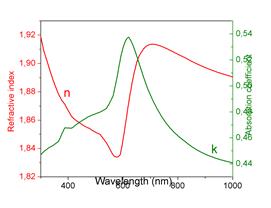"METAL-POLYMER NANOCOMPOSITES OBTAINED BY COMBINED PLASMA TEHNIQUES" |
TE_229 |
|
Stage III. Synthesis, using simultaneous PECVD/PVD deposition, of metal-polymer nanocomposites materials with controlled surface plasmon resonance frequency. Studies of the interaction between the species generated by PECVD and PVD plasma sources under simultaneous functioning; Synthesis of metal-polymer nanocomposites materials with antimicrobial or/and biocompatibility properties using sequential or simultaneous deposition in the hybrid PECVD/PVD system.ilitate
Representative images associated to the results obtained in the third stage of TE_229 project
|
 |
Histogram of the particles diameters obtained during the synthesis of Cu-PPY composite material; in the inset: typical AFM image of Cu-PPY composites containing spherical |
Refractive index and absorption coefficient of Cu-polypyrrole composite materials |
# Spherical structures consisting of Cu nanoparticles surrounded by a polypyrrole thin layer are present on the composite surface; typical dimension is in the range 50-150 nm;
# Optical investigations evidence a strong absorption band in the wavelength region around 620 nm, typical for the generation of Cu surface plasmon resonance.
|
|
OES spectrum of the magnetron sputtering discharge working in Ar atmosphere at 100 W |
Cu and Ar emission intensities as function of the applied RF power on the magnetron |
# Cu I lines as well as Ar I and Ar II lines dominate the emission spectra of the plasma generated by magnetron sputtering plasma source;
# The maximum intensity of the copper line is obtained around 100 W, value which was chosen for composite synthesis.
|
|
The emission spectra of Ar/HMDSO (black line) and Ar/HMDSO/O2 plasma in the regions corresponding to a) OH 3064 system and b) CO Angstrom system |
# The emission spectra of the PECVD plasma working in Ar/HMDSO mixture reveal the presence of excited Ar atoms and ions as well as Ha and Hb lines;
# The presence of the small signal corresponding to the OH and CO emission reveals the dissociation of HMDSO in plasma.
|
Mass spectra of Ar/HMDSO mixture without plasma (black line) and with 20 W RF plasma (red line) |
# The mass spectra of Ar/HMDSO mixture presenting the main peaks at 73 amu (Si(CH3)3), 132 amu (Si2OC4H11) and 147 amu (Si2O(CH3)5);
# Plasma ignition induce a diminishing of these peaks due to additional dissociation processes of HMDSO in the plasma.
|
|
Images of the L929 fibroblast cells growth on the Ti-HMDSO composite materials synthesized in a hybrid PVD/PECVD system |
Cell viability for the L929 fibroblasts growth on the composite materials synthesized in a hybrid PVD/PECVD system |
# Ti-polysiloxane composite presents better biocompatibility properties as compared with Cu-HMDSO and HMDSO materials;
# Ccell viability exceeds 120% in comparison to the witness.
|

